X-rays
1/13
Earn XP
Description and Tags
Name | Mastery | Learn | Test | Matching | Spaced |
|---|
No study sessions yet.
14 Terms
what are x-rays?
electromagnetic waves
can be polarised and diffracted
have low wavelength (10^-11) and high frequency
their photons have 10-10000 times more energy than visible light
ionising radiation (can harm and kill living cells)
how are x-rays produced (part 1)
in an evacuated tube
a low voltage supply heats up the metal cathode, causing it to produce electrons by thermionic emission
these electrons are accelerated towards the anode through a high p.d (30-100kV)
the anode is made from a target metal (eg tungsten) with a high melting point
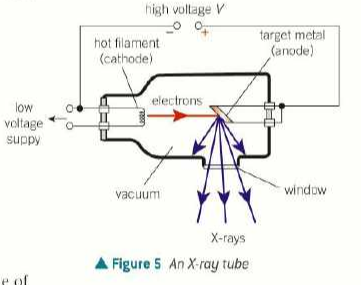
how are x-rays produced? (part 2)
when the electrons hit the anode, they decelerate and x-ray photons are produced
less than 1% of electron energy transferred to photons (the rest is transformed to thermal energy)
water or oil is used to cool the anode, or it is rotated
the x rays are emitted in the desired direction using a window
the tube is lead-lined to shield from x-rays in other directions
how do you find the wavelength of the x-ray photon from just the p.d?
due to conservation of energy, the maximum energy of photon=maximum kinetic energy of one electron
therefore hf=QV
hc/lamda=eV
lamda=hc/eV
wavelength is inversely proportional to accelerating p.d
what are the spikes in intensity on an x-ray spectrum?
when a bombarding electron removes an electron that was inside an atom, a gap is created
higher energy electrons drop down to that electron’s level to fill the gaps
this releases a photon of a specific energy and wavelength
the increase in energy causes a spike in intensity
what does an x-ray spectrum look like?
the range of decelerations of the electrons produces the broad background of bremsstrahlung (braking radiation)
what is attenuation?
the decrease in the intensity of electromagnetic radiation as it passes through matter
as x-rays travel through flesh, some of their photons are scattered or absorbed so the intensity decreases
what is simple scatter?
happens for photons with energy of 1-20keV
photon interacts with electron in atom
photon doesn’t have enough energy to remove the electron, so it just bounces off (is scattered)
photon’s direction changes but energy doesn’t
insignificant because X-ray machines have p.ds greater than 20kV
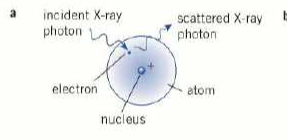
what is the photoelectric effect?
photon energy < 100keV
photon is completely absorbed
electron uses energy to escape atom so electron emitted
main mechanism for soft (lower energy) X-ray attenuation
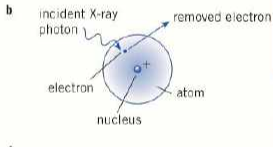
what is compton scattering?
photon energy is 0.5-5.0MeV
photon interacts with electron inside atom
electron is emitted
photon is scattered with reduced energy
used in hard X-rays to kill cancerous cells?
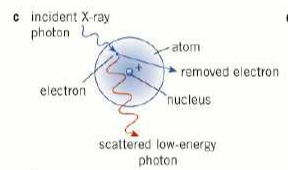
what is pair production?
photon energy>1.02MeV
x-ray photon interacts with nucleus
photon disappears
electron and positron pair produced
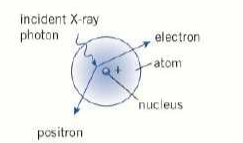
what is the equation for final intensity of X-ray?
I = I0e-mu * x
where x=thickness of material, I0 is initial intensity and mu is the attenuation coefficient (like how much the material absorbs x rays)
what and why are contrast media?
they are materials with high absorption coefficients which are injected or consumed by the person getting x-rayed
as soft tissues have low absorption coefficients, a constrast medium improves the visibility of their internal structures by contrasting with the soft tissues
attenuation coefficient is proportional to atomic number cubed (Z3)
main two= barium and iodine (high atomic numbers)
barium is swallowed to do digestive system stuff
iodine is injected for blood vessels and stuff
how are x-rays used in therapy?
high energy x-ray photons kill off cancerous cells
via compton scattering and pair production